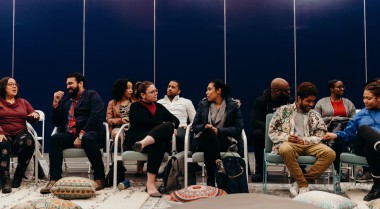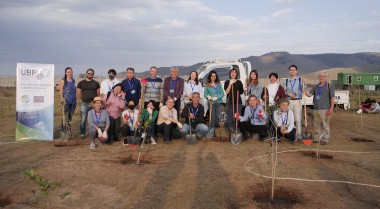
How to sustain youth leadership in peacebuilding: Unveiling the transformative power of networks
As my plane descended into Amman, Jordan, in the middle of the night in April of 2024, I found myself, mere hours later, amidst a dynamic dialogue on Youth, Peace, and Security (YPS) organised by the International Dialogue on Peacebuilding and Statebuilding (IDPS).
In this discussion, I joined Member State representatives, development partners, young peacebuilders, and civil society for an interactive exchange on the YPS Agenda. The goal of the discussion was to jointly explore opportunities for increasing youth-responsive engagement in contributing to peacebuilding and statebuilding.
What became evident during those two days in Amman was truly remarkable – a resounding acknowledgement and respect from young individuals around the world for the crucial role networks play in the work of young people.
In the following paragraphs, I'll share key insights emerging from the IDPS discussion and delve into the indispensable role networks play in sustaining young people’s leadership in peacebuilding. I'll shine a light on the factors that often make donors pause when considering financing for networks, and provide concrete recommendations for overcoming these challenges.
Sustaining youth leadership in peacebuilding: The power of networks
Right at the start of the meeting, young people asked a key question, prompting a fundamental reflection: Who is the YPS Agenda for?
Implicit to this question lies a crucial assumption: that the YPS Agenda is crafted by and for the youth themselves. We must remember that the landmark Security Council resolution on YPS (S/RES/2250) was adopted as the result of several years of advocacy by over 11,000 young people from over 110 countries. Subsequently, the YPS Agenda would not progress without young people’s leadership, as Member States continue to approach the YPS Agenda with caution and rarely champion it in the work of the Council or elsewhere in the global policy space.
This recognition shifts towards a concern: how can we ensure the sustainability of YPS leadership when the youth leaders of today inevitably reach an age threshold, yielding their space to the next generation?
In response, the unanimous consensus in the room was that networks are best positioned to sustain youth leadership in peacebuilding. How?
- First, networks are able to shape leaders through learning and exchange, including through intergenerational dialogue. Networks do not strive to be a comprehensive knowledge system but aim to offer a stimulating framework that facilitates exchange and access to knowledge sources.
- Second, networks are able to make young people’s leadership effective through their representative structures and access points. Networks often act as a safe umbrella that brings people together across divides. They allow people to share access points and valuable strategic information. They also create an inclusive and equal space for dialogue and move beyond one-off exchanges with individual actors.
- Finally, networks are capable of facilitating the transition of knowledge from one leader to another. The networks consist of representatives of diverse constituencies and they profit from the diversity of their constituencies and bring together their various strengths. At the same time, networks have structures in place that allow young people to transition into a supportive role after their age threshold is met and continue harnessing the youth leadership of the new generation.
The impact of the networks therefore becomes unprecedented. Networks have an infrastructure to raise, leverage and sustain the leadership of young people in peacebuilding. They build active community constituencies committed to peace, drive new generations to think about peace and security differently, infiltrate militarised propaganda, and offer young peace a nonviolent alternative to building livelihoods.
Navigating donor caution: Challenges and perceptions surrounding network financing
Simultaneously, networks are met with a cautious gaze from donors. Insights garnered from GPPAC's recent inquiry into financing for local peacebuilding shed light on several reasons underlying this apprehension:
- First, effective networks require significant resourcing. Networks do not function as regular intermediary organisations. For networks to grow and advance their goals, investment is required for building a network mindset, network coordination, and member engagement, in addition to programmatic work.
- Second, the impact of the networks is hard to quantify. The recent discussions on the engagement of the private sector in financing young peacebuilders’ work become complex, as it is hard to explain to a donor, let alone an investor, how networks can advance resilience and sustain peace. The changes that networks achieve are often hard to quantify using traditional M&E methodologies.
- Third, donors find it difficult to trace the money once the money reaches networks. It is hard for the donors to track who receives the money and how the resources are spent.
Donors and investors of today are not ready to trust networks with a significant amount of resources. Despite the unprecedented capacity of networks to sustain peace for everyone, they struggle to sustain themselves because of the lack of trust and the lack of capacity of the donor community to embrace the unknown and take risks. No matter how innovative young people’s methodologies are, donors are unwilling to give money to young peacebuilders who often do not have a track record of managing large sums of money.
Similarly, policymakers are afraid to let young people engage in policy negotiation. Systemic challenges of youth engagement in policymaking are rooted in hierarchical modalities that assign the power at the negotiation table to the age and (often) gender of a negotiator. The assumption is that one can only be strategic and effective in policymaking once they have years of negotiating experience.
Next steps: What can donors do to support youth leadership in peacebuilding?
There are some steps that donors could take in supporting networks that sustain the leadership of young people:
- Test investment in networks: By taking the lead in incentivising consortia and coalitions, donors will inevitably encourage organisations to coordinate and bring those who would not be able to obtain resources individually on board. One approach to do so is by pooling risks and investing in pooled funds that can test out the impact of the network approach in a specific context.
- Take time to build trust: Donors could prioritise funding arrangements that establish long-term partnerships that continually build trust and collaboration between donors and young peacebuilders.
- Move beyond outputs: Donors can incentivise network collaboration and engagement. This could be done by supporting specific convening and conference grants to support local peace actors to access a greater diversity of knowledge and experience, expertise, and constituencies.
- Recognise youth expertise: Donors should adopt participatory grantmaking methodologies by including young people in the process of developing calls for proposals. This would enable donors to understand the way young people think about impact and support their actions.
It is time to shift the mindset from cautious to trusting and embrace the uncertainty, allowing young people to have a safe space in which they can thrive and deliver better peace outcomes for everyone.


